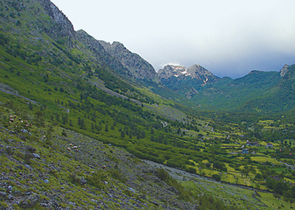Prokleté hory nejsou vůbec prokleté

The Damned (Prokletije) Mts., a mountain range in the Balkans that extends from northern Albania to southwestern Kosovo and eastern Montenegro, is no doubt among European areas to the smallest extent influenced by humans. Visitors have only recently discovered its beauty, but it is just a matter of time where also the forgotten part of the Balkans will be dramatically changed. Nevertheless, the landscape is being used in the same way as dozens or probably centuries ago, i.e.by livestock grazing. Small field patches very closed to human settlements provide local inhabitants with basic food. At more remote sites, grazing has been irregular and the landscape has been relatively well healthy. While a botanist meets species-rich plant communities and wild plant populations which cannot be found elsewhere in Europe, forests as well as fauna have been preserved in a rather worse status there. The remnants of forests are mostly beech ones, somewhere with hornbeam, spruce or pine trees. They have been managed as coppice or sucker growths: therefore, also because of broken forest edges, many passerines and other small birds nest in such habitats. The Damned Mountains harbours many endemic or relict wildlife species (e.g., the alpine plant Wulfenia baldaccii)or those considered being critically threatened across the whole continent.
Nature Conservation 6/2010 — 28. 12. 2010 — International Nature Conservation — Print article in pdf

